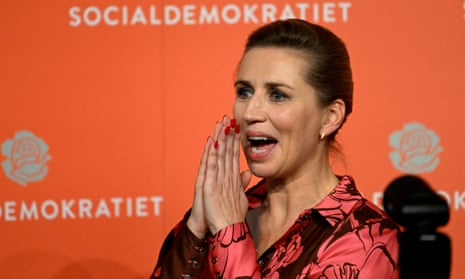Denmark’s prime minister, Mette Frederiksen, has won a nail-biting election that gave her left-leaning bloc a one-seat majority in parliament. But her pledge to build a broad left-right coalition may make it difficult for her to form a stable government.
Exit polls on Tuesday night had suggested Frederiksen’s five-party “red” bloc would lose its majority in the 179-seat parliament, but as the last votes were counted early on Wednesday it became clear that it had secured 87 seats in mainland Denmark.
Three more seats from the autonomous overseas territories of the Faroe Islands and Greenland gave it a total of 90 MPs – the slimmest possible majority – as Frederiksen’s Social Democrats turned in their strongest showing in more than 20 years, winning 27.6% of the vote and 50 MPs.
“Thanks to all Danes who have trusted us with your vote, it’s a huge vote of confidence,” the prime minister said on Wednesday. “I know some of you have had doubts along the way … We are a party for all of Denmark.”
The result, however, leaves Frederiksen with a dilemma: she campaigned for a broad coalition of mainstream parties across the traditional left-right divide, arguing that political unity was needed at a time of domestic and international uncertainty. Her majority could make that more difficult to achieve, since most of her leftwing allies would prefer a traditional left-leaning alliance.
“She could opt for a straight leftwing bloc, which would mean going back on her campaign promise of political unity, or she can keep her word and risk upsetting her traditional allies,” said Sune Steffen Hansen, a public affairs consultant, pollster and former adviser to the Social Democrats.
“Whatever she does, she could disappoint a lot of people. In a parliament with 12 parties – a really fragmented political landscape – and with such big issues facing the country, holding a coalition together is not going to be easy.”
Frederiksen, 44, presented her government’s resignation to Queen Margrethe on Wednesday morning and said she intended to push ahead with her plans.
“When the Social Democrats say something, we follow through,” she said. “We must get through uncertain times together. The Social Democrats went to the polls to form a broad government. If a majority of parties point to me as prime minister I will see whether it can be done. That is what is good for Denmark.”
Frederiksen is expected to turn first to her centre-right predecessor, the former Liberal party leader Lars Løkke Rasmussen, whose hopes of becoming kingmaker were dashed by his rival’s majority but whose new centrist party, the Moderates, won 16 parliamentary seats, also with a call for a new left-right coalition.
Løkke Rasmussen insisted on Tuesday night he still wanted to be “the bridge” across the traditional divide in Danish politics. “It’s not red or blue, it’s about common sense,” he said, adding that a new government was “a certainty”.
However, although Løkke Rasmussen is certain to take part in Frederiksen’s coalition talks and could even secure cabinet posts, analysts are not sure he can compromise enough for the left without drawing fire from the right, potentially forcing Frederiksen to revert to a more traditional leftwing coalition.
after newsletter promotion
In a bad night for the right, the opposition “blue” bloc – an informal liberal and conservative alliance supported by three populist parties – won 73 seats. The opposition leader, Jakob Ellemann-Jensen, of the Liberal party, acknowledged the bloc’s defeat after his party lost 19 of its 43 seats in parliament.
Frederiksen was rewarded by a public vote of confidence in her handling of the Covid-19 pandemic and in her steady leadership in the face of high energy prices, rampant inflation and mounting insecurity fuelled by Russia’s war on Ukraine.
She had won praise for navigating Denmark through the pandemic, but her popularity slipped, partly over a decision to cull the country’s entire captive mink population of 15 million animals for fear of a Covid-19 variant crossing over to humans. A parliament-ordered inquiry found the move was illegal and last month one of the parties propping up Frederiksen’s minority government threatened to topple it unless she called elections.
Denmark’s stricter immigration policies slashed support for the far-right Danish People’s party, but a new party, the Denmark Democrats, created by the former immigration minister Inger Støjberg, scored 8% of the vote.
